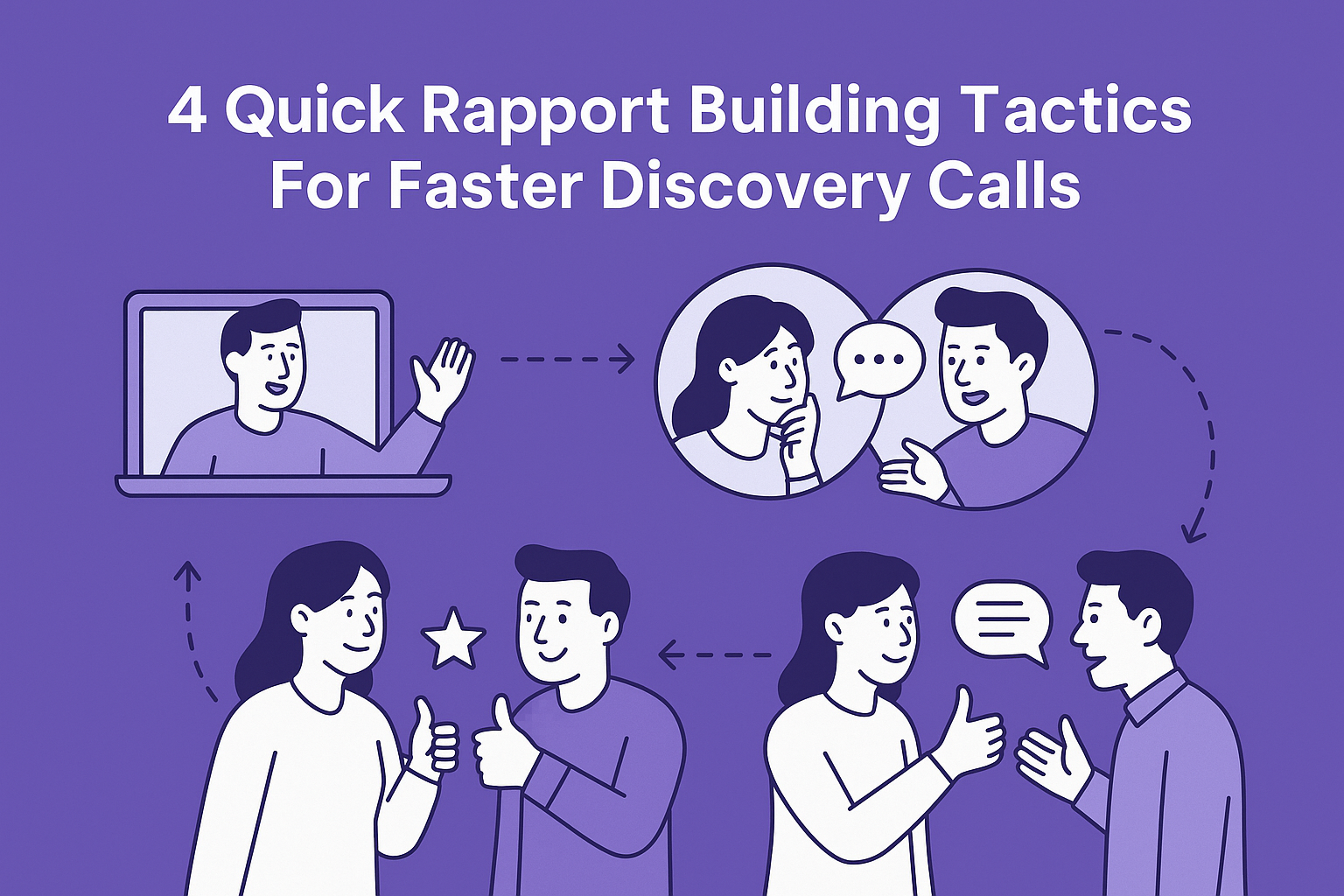4 Quick Rapport Building Tactics For Faster Discovery Calls
-
Kehinde Fatosa
- 10 min read

First impressions on intake calls can make or break the deal.
When your prospect hops on the call, you’re racing against the clock, trying to build trust, uncover pain points, and qualify or disqualify… all in 30 minutes or less.
But here’s the catch: if there’s no rapport in the first few minutes, the rest of the call becomes a transactional Q&A.
No depth. No real insights. And no sale.
So what separates discovery calls that convert from those that fall flat?
It’s not just having a script. Or pitching your solution earlier.
It’s your ability to build rapport, fast and naturally.
And no, I don’t mean asking “How’s the weather over there?” or commenting on their Zoom background. That’s not rapport. That’s small talk.
Here are 4 quick rapport building tactics grounded in real buyer psychology that help you move from surface level to substance, without wasting time.
Tactic 1: Reframe the Power Dynamic with a Soft Disclaimer
Most prospects come into discovery calls guarded. They’ve been pitched to. Sold to. Rushed through demos. So when you open the call with a generic “Tell me about your business,” it reinforces the usual dynamic:
Them = the buyer
You = the seller trying to close
This triggers sales resistance.
Flip the dynamic.
Start with a soft disclaimer that puts you back in the advisor seat and makes them feel safe:
“Just so you know, this isn’t a typical sales call. My goal is to understand if what we do can actually help. If it’s not a fit, I’ll let you know. And if it is, I’ll walk you through what that looks like.”
This short sentence does 3 things at once:
- Signals honesty (you’re not desperate to close)
- Builds authority (you control the call)
- Creates safety (they’re not being sold to)
And when people feel safe, they share more. Faster.
Tactic 2: Use Specific Praise That Signals Research
Most prospects are used to compliments that feel robotic:
“I checked out your website, it looks great!”
“You’re doing really cool stuff at (company name).”
It’s noise. They’ve heard it before. It doesn’t build trust, it triggers skepticism.
Instead, use specific praise that shows you actually did your homework.
Let’s say you’re talking to a Head of Research at a fintech company. Instead of the generic compliment, you say:
“I noticed your team recently rolled out that new risk profiling tool. It’s impressive how you simplified such a complex feature, was that based on user research?”
Boom. You’re now:
- Validating their expertise
- Showing deep context
- Creating space for a meaningful answer
This kind of praise is earned, not flattery, and it shortens the distance between stranger and trusted peer.
Tactic 3: Ask Emotional Contrast Questions
People don’t buy products. They buy progress. And the fastest way to surface their pain (and desire) is by asking about contrast.
Not just “What’s the problem?” but “What’s the shift you want to see?”
Here’s a classic move:
“Let’s say it’s 3 months from now and you’ve solved this—what’s different in your day to day?”
“Now compare that to what’s happening today. What’s costing you the most?”
These two questions work because they invite the prospect to emotionally visualize what success looks like, and feel the gap between current pain and future ease.
Why it builds rapport fast:
- You’re speaking to their reality, not your solution
- You’re helping them articulate what they may not have fully named yet
- It positions you as a guide, not a seller
And when someone feels seen and understood, they relax. They start giving you real, unfiltered answers. Which means you get to qualified insights faster.
Tactic 4: Mirror Their Language in Real Time
This one is subtle but powerful.
If your prospect says:
“We’re just drowning in raw data and can’t make sense of what’s actually actionable.”
You don’t respond with:
“We help companies analyze data faster.”
That’s a mismatch. It feels like a pitch.
Instead, mirror their language back with empathy:
“Totally makes sense, so it’s not the volume of data that’s the issue, it’s the lack of clarity on what’s actually usable?”
This signals 3 things:
- You’re truly listening (most people don’t)
- You value their perspective
- You’re meeting them where they are, not forcing your narrative
Psychologists call this verbal mirroring. It taps into how our brains are wired for connection.
And it works even better when you mirror both language and emotion. If they sound overwhelmed, match their tone. If they sound skeptical, slow down and meet their energy.
You’re not imitating. You’re syncing. That sync builds trust, quickly.
Wrapping Up: Fast Rapport = Faster Calls = Faster Deals
Here’s the truth: You don’t need to “build a relationship over time” to win deals.
You need to build enough trust, fast**,** so people tell you what they really need. That’s the point of discovery calls.
So instead of wasting the first 10 minutes on fluff or fake rapport, apply these 4 tactics immediately:
- Start with a soft disclaimer to signal safety and authority
- Give specific praise that proves you did your homework
- Ask emotional contrast questions to uncover pain and desire
- Mirror their language and energy to deepen trust in real time
Do this, and you won’t just run better discovery calls. You’ll build relationships that convert. Fast.
P.S. Want to eliminate the most time consuming part of discovery calls – digging through raw data post call to extract insights?
Insight7’s Evaluation turns your calls, notes, and survey data into instant business recommendations, no prompt engineering or technical skills needed.
Just upload your files, and get real answers.







